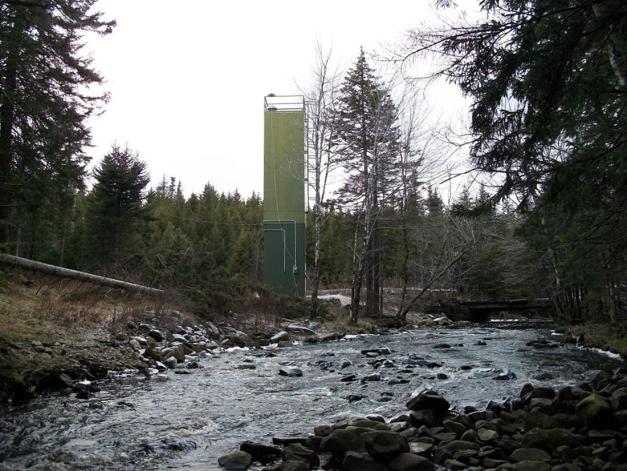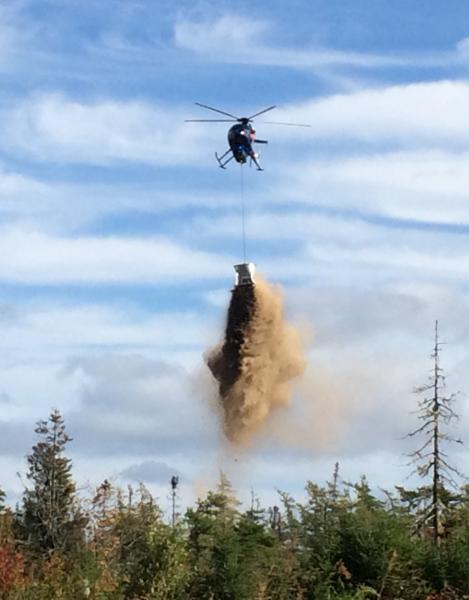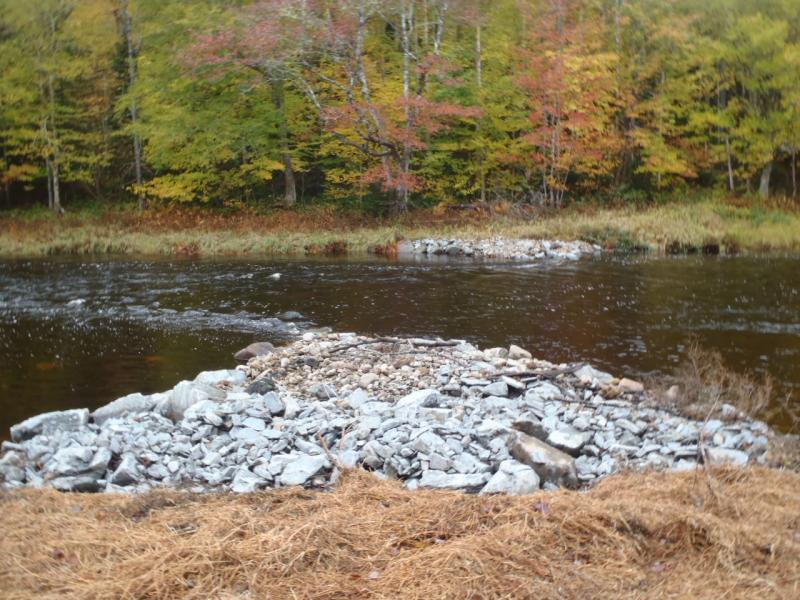Follow updates on our Facebook page
Acid precipitation directly affects freshwater fisheries more than 65 watersheds along the Atlantic coast of Nova Scotia and has reduced international angling-related tourism, angling-related jobs and economic  spin-offs. These impacts are particularly prevalent in rural communities where angling was a major socio-economic activity. Despite the international commitment to the Clean Air Act of 1990, a legacy of acid rain impacts continue to limit fish populations and recreational fisheries by rendering otherwise suitable habitat unfit for fish reproduction and rearing.
spin-offs. These impacts are particularly prevalent in rural communities where angling was a major socio-economic activity. Despite the international commitment to the Clean Air Act of 1990, a legacy of acid rain impacts continue to limit fish populations and recreational fisheries by rendering otherwise suitable habitat unfit for fish reproduction and rearing.
The Nova Scotia Salmon Association has been a leader in the fight against acid rain in Canada. Since 2005, we have led the West River, Sheet Harbour Acid Mitigation Project. Deemed “arguably the most important restoration initiative for Atlantic Salmon and Trout on the East Coast of Canada” by leaders in fish conservation, this program uses cutting edge technologies and complimentary activities to addresses the multiple threats affecting salmon and trout populations in this watershed located 90 minutes north of Halifax. This project engages our local affiliate (the Eastern Shore Wildlife Association), our provincial members, three levels of government, several academic institutes and First Nations to restore recreational fish populations in this river and to develop a framework toward restoration that can be applied to other acid-impacted fisheries. In addition to direct acid mitigation (i.e. liming), the NSSA has conducted rigorous scientific monitoring of the response of Atlantic Salmon (e.g. annual smolt monitoring, adult monitoring and electrofishing), other ecosystem components (e.g. stream invertebrates) and water chemistry.
The cornerstone of the WRSH project is the operation and maintenance of an automated lime doser which buffers the river water toward more suitable pH. This lime doser is the first of its kind in North America and, by administering some 300t to 500t of powdered limestone per year, has increased the annual production of Atlantic Salmon smolts from 3000 to over 10 000 and has led to more favorable Brook Trout angling in the West River and its estuary. It currently treats 30 linear km of river habitat .
Despite the project success to date, careful study has identified that the liming initiative is on the cusp of realizing a substantially greater impact. Many restoration projects experience similar thresholds above which the desired outcome is possible (e.g. a critical mass must be achieved). Specifically, we have identified the following needs:
(1) raise the pH of the lowermost section of river a small amount over our current abilities
(2) raise the pH of the Killag River (major tributary to the West River, Sheet Harbour) which the current lime doser does not treat however where much of the salmon spawning occurs,
(3) restore the physical habitat in the main branch of the river to improve holding, spawning and rearing habitat, reduce ice formation and reduce summer heat gain,
(4) remove the fine sediment impacting the spawning habitat within the main river and Killag River, and
(5) undertke and examine the utility of catchment liming for the treatment of highly acidified tributaries
Restoration :
To address the factors limiting the recovery of fisheries in the West River, Sheet Harbour, we have undertaken a multi-faceted expansion of the earlier project that uses scientifically-supported novel approaches. A scientist / project manager (April 2016) has be hired specifically to plan and oversee the expansion. The program will involve three major components:
1) The installation of a second lime doser on the Killag River, a tributary of the West River, Sheet Harbour where physical and thermal habitat are near optimal. Operational in the fall of 2017,
2) A catchment liming project located on a highly acidified tributaries that empties into a critical section of the currently lime-treated West River that began in the fall of 2016 and continued in the fall of 2017, and
3) The restoration of physical habitat located within the lime-treated section of the West River which is of poor physical condition and also the removal of fine sediments from spawning habitat within the Killag River which began in the fall of 2016 and completed 18km by the fall of 2017..
Killag lime doser:
Raising the rivers pH of the West River below the confluence with the Killag River to our biologically-relevant target requires the addition of a second lime doser to the Killag River – the largest tributary within the watershed. The Killag powdered limestone doser will push the project past the anticipated threshold in this lowermost section of river and, additionally, it will also treat more than 16 km of the Killag River which is generally cooler and provides some of the best rearing habitat in the watershed.
Combining a Killag and West River lime doser is consistent with the recommendations of Dr. Atle Hinder, a world-expert on liming from Norway, who was commissioned to assessed the potential for liming in Nova Scotia . In 2005, the Killag River site was the preferred location to place the first lime doser, however neither the power supply nor access to the site existed. Since 2005 however, improved solar generating equipment and remote control devices now permit operation of a lime doser in the middle of the Nova Scotia wilderness. Further, recent gold mining operations will refurbish and maintain an access road to the site. As is evident with the West River doser, we have the experience and capacity to operate such as machine long-term. We have the infrastructure in-place to address the requirements for maintenance and management of ongoing operations. Further, a dedicated 17 person volunteer fundraising team will continue to solicit the necessary funding to run the West River Project, as has been done since 2005. Adding this doser will increase the well limed salmon habitat from a current 12% to 75%. This lime doser holds 100 tons of lime and was turned on in December 2017.
Catchment liming:
 Lime dosing is a favorable method for treating acid-impacted rivers as it requires relatively low initial capital costs and permits the treatment of a large quantity of water. However, a drawback is that it requires constant maintenance and is not applicable to small tributaries which are often important for salmonid spawning. An alternative is terrestrial/ catchment liming where powdered lime spread across the river catchment supplies cations to the soils, reduces the mobility and toxicity of some metals (e.g. aluminum) and ultimately increases the pH of streams draining the treated catchment. This method has the potential to last in excess of 25 years without reapplication, however the high initial costs associated with spreading the lime (e.g. by helicopter) is often prohibitive and this technique remains poorly tested in North America.
Lime dosing is a favorable method for treating acid-impacted rivers as it requires relatively low initial capital costs and permits the treatment of a large quantity of water. However, a drawback is that it requires constant maintenance and is not applicable to small tributaries which are often important for salmonid spawning. An alternative is terrestrial/ catchment liming where powdered lime spread across the river catchment supplies cations to the soils, reduces the mobility and toxicity of some metals (e.g. aluminum) and ultimately increases the pH of streams draining the treated catchment. This method has the potential to last in excess of 25 years without reapplication, however the high initial costs associated with spreading the lime (e.g. by helicopter) is often prohibitive and this technique remains poorly tested in North America.
Here, we have conducted a large scale catchment application in two phases; phase one in 2016 focused on the headwater riparian areas of Keef Brook, a highly acidic tributary of the West River which was expected to produce results within six months but showed very positive results almost immediately, has lasted well during 2017 and is expected to last more than 15 years. Phase two, conducted in 2017, focused on lower portions of this catchment and areas likely to contribute to long-term (years 5-25+) acid neutralizing capacity. This project is guided by a multi-disciplinary committee formed by the DFO Southern Upland Salmon Recovery Planning Working Group and it engages the NSSA, provincial and federal agencies, two academic institutions, First Nations, fishing associations and industry. All planning, including the development of cutting-edge predictive groundwater-surface water interaction models uses the most up-to-date scientific knowledge to offer the best opportunity of project success.
Physical habitat:
Finally, the issue of acidification is not the only factor limiting the production of recreational fishes in this watershed. A legacy of poor but historic land use has altered the instream habitat inc luding logging, 72 dams and log-driving. Currently, the natural pool-riffle sequence has been interrupted and the channel has been artificially widened such that fish migration is hindered, water temperature reaches near-lethal levels during summer and significant ice forms in the winter. Finally, a network of past logging roads and logging activities have introduce fine sediments in some sections of the watershed; embedding substrate and reducing its suitability for salmonid spawning.
luding logging, 72 dams and log-driving. Currently, the natural pool-riffle sequence has been interrupted and the channel has been artificially widened such that fish migration is hindered, water temperature reaches near-lethal levels during summer and significant ice forms in the winter. Finally, a network of past logging roads and logging activities have introduce fine sediments in some sections of the watershed; embedding substrate and reducing its suitability for salmonid spawning.
We are addressing the most egregious habitat issues in the main branch of the West River in the section between the confluence of the West-Killag Rivers downstream to Sheet Harbour Lake. This work is in a section of the river that has been limed for 10 years, however pairing liming and physical habitat work is increasing the freshwater production of Atlantic Salmon and Trout in this area by increasing the amount of spawning and rearing habitat. Further, these structures are providing holding habitat for upstream migrating adult salmon and are facilitating migration to upstream habitats. It is believed that this 6.9 km section, which is wide, shallow and exposed without holding habitat for adult fish, currently presents a partial migration barrier. To address the issue of fine sediment, we are using a ‘Sand Wand’ to remove sand and silt from selected spawning habitat on the main river and the Killag River. The location of the proposed work was identified during watershed planning initiatives and is the site of long-term electrofishing sites which have indicated highly variable recruitment of juvenile salmon and trout.
In 2016, 400m of the river was improved through the addtion of deflectors and rock sills which will work with the flows to restrore the riffle / pool pattern over the next few years. By the summer of 2017 these structures had clearly begun to established riffles above the structures and in the fall had 28 Salmon redds plus Trout redds in an area that had not had spawning before. In 2017 a further 1.2km of stream was restored in the same way and the Salmon and Trout did use it for limited spawning even though the flows had not had a chance to sort the river bed.
